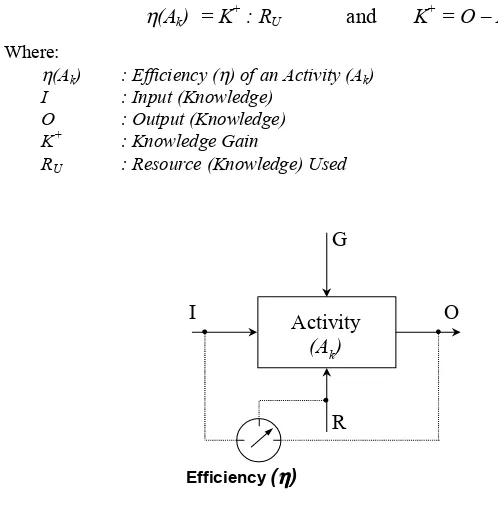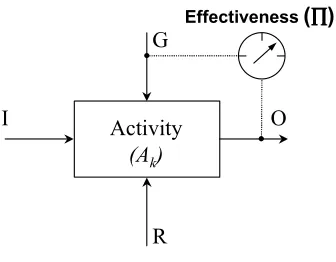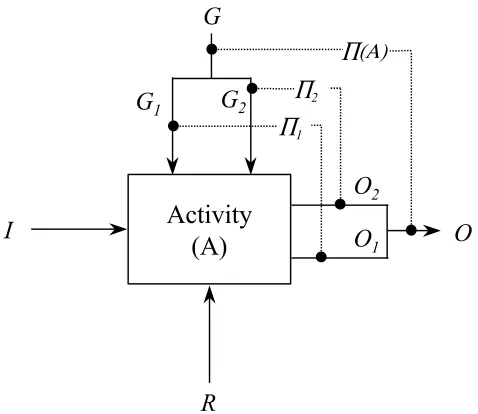INTERNATIONAL CONFERENCE ON ENGINEERING DESIGN ICED 01 GLASGOW, AUGUST 21-23, 2001
PERFORMANCE MANAGEMENT AT DESIGN ACTIVITY LEVEL
F J O’ Donnell and A H B Duffy
Keywords: Design Management; Design Development; Performance.
1 Introduction
The overriding aim of much of the engineering design research is to improve the performance of the design process, and consequently the product development process. Much has been written within the product development literature on the performance of the product development process [1]. This work has been largely focused on the analysis of performance at the project or program level. The ability to relate the different research and draw generic lessons from the results has been stifled by the lack of consistency on the meaning of performance both at a generic level [2] and more specifically in design/development [3]. For example, although product and process performance have been distinguished within existing work we are unclear on how these relate or may be managed effectively.
This paper begins with a brief review of research in the area of performance, with particular emphasis on design/product development, highlighting the main weaknesses in work to date. A fundamental and generic model of performance, related to knowledge based activities in design, is then presented. The model describes performance in terms of its key elements, efficiency and effectiveness, and provides a basis for modelling performance across different process levels, i.e. project, program, etc.
2
Research in design performance
The research reviewed here forms part of the overall research in the area of performance of organisations. Some of the work is generic in terms of being applicable across all business processes while other work is aimed at more specific processes such as product development, design, manufacturing, etc. (Figure 1). Within such areas the type of research and focus may vary widely and include empirical studies aimed at determining relationships between performance in different processes, the design and implementation of approaches for measuring performance, the development of theoretical performance models, etc.
2.1 Trends in Performance Research
no papers focused specifically on the analysis of design development performance from a list of over 90. Many authors have recognised the particular difficulties in measuring the performance in design/development activities [4-6]. These difficulties arise from the less tangible nature of outputs from design activities, i.e. knowledge, the often long duration and wide range of influences from design to market launch, the difficulty in defining/measuring design quality, etc.
Business Processes
Product Development
Manufacturing Design
….
• Theoretical analysis
• Performance measurement approaches
• Empirical studies
• Research Reviews
[image:2.612.114.489.162.267.2]• …..
Figure 1. Areas and Types of Performance Related Research
The decline of management accounting as the only way to measure business performance is an indication of the move toward measuring less tangible aspects of performance, e.g. those related to knowledge intensive activities in design. Johnson and Kaplan [7] suggest that traditional accounting methods are unsuited to organisations where the product life cycle is short and research and development assume increased importance.
Within the scope of this paper two areas of existing research in performance are briefly reviewed, i.e. the definition/modelling of performance and the relationship between design and design activity performance.
2.2 Defining and Modelling Performance
The literature on performance is characterised by a lack of, and inconsistency in, definition of terms. Numerous works have been published which directly address the area of performance but do not explicitly define performance itself. Neely [8] in his review of performance literature suggests that “Performance measurement is a topic which is often discussed but rarely defined”. Meyer [9] suggests that there is “massive disagreement as to what performance is” and that the proliferation of performance measures has led to the “paradox of performance”, i.e. that “organisational control is maintained by not knowing exactly what performance is”. That is, the lack of a comprehensive understanding of performance can often lead to ignorant acceptance of particular approaches, metrics, etc., proposed by senior management in an organisation.
the capability for a process, such as design or manufacture, to change rapidly may add unnecessary cost/overhead in a stable environment. Flexibility will influence the performance, i.e. efficiency and/or effectiveness of an activity/process, but does not constitute a dimension of performance itself.
In summary, the research in performance has been hindered by a lack of clarity on its meaning. In particular:
• The key elements of performance have not been consistently defined or agreed.
• Those defining performance as efficiency and effectiveness have not distinguished them clearly and/or related them within a formalism of performance.
• Many of the measures used in the research relate to influences on performance and not performance itself.
2.3 Design and design activity performance
Design activity modelling has received significant attention over the years aiming at the development of both descriptive and prescriptive models. This has resulted in the development of models offering different viewpoints of the design process such as the prescription of the activities/stages in design and their logical sequence, others focused on the cognitive nature of design and those relating design within an overall model of product development. These models are aimed at increasing our understanding of design (descriptive), and/or providing a framework (procedures, guidelines, etc.) in which to carry out design (prescriptive), so that the level of performance may be maintained or improved. However, performance in design requires continued attention to both the design (artefact) and the activities involved in producing that design. That is, both design (DG) and design activity goals (DAG) exist within design development and performance in relation to these goals must be distinguished yet related to overall performance. Design goals relate to aspects of the design (artefact) such as its dimensions, its form, etc. while design activity goals relate to the activities in design development and consider aspects such as the time taken and cost of resources.
There is a reasonable consensus within existing models on the types of activities involved in design, their sequence, etc., and the evaluation of the output in relation to the design goals is a key component of the models discussed. However, the analysis of performance in relation to the activities carried out in design is restricted to literature addressing the management of design at the project level, e.g. [10]. It is proposed here that management activities are carried out at every level in design and therefore there is a requirement to analyse performance in relation to such activities at all levels.
3
A design performance model – E
2Although there is widespread use of efficiency and effectiveness to describe performance there are a variety of interpretations of these terms when applied in design and development. Efficiency (η) and effectiveness (∏) are presented here as fundamental elements of performance which may be used to fully describe the phenomenon. That is:
≡ Efficiency (η) and Effectiveness (∏)
A new model, E2, is presented here as a novel and unique means to clearly formalise the phenomenon of design performance and allow efficiency and effectiveness to be distinguished and related. Efficiency is related to input, output and resources, while effectiveness is determined by the relationship between output and goal(s). These elements are presented within the E2 model providing a fundamental representation of activity performance.
3.1 Efficiency
In general, the efficiency of an activity is seen as the relationship (often expressed as a ratio) between what has been gained and the level of resource used. Assuming design as a knowledge processing activity (Ak) (Figure 2), the difference between the output (O) and the input (I) defines the knowledge gain from the activity (K+). The cost* of the activity may be determined by measuring the amount of resource knowledge used (RU). Therefore, the efficiency of this activity may be depicted as in Figure 2 and formulated as a ratio:
η(Ak) = K+ : RU and K+ = O – I
Where: η(Ak)
I O K+ RU
: Efficiency (η) of an Activity (Ak)
: Input (Knowledge) : Output (Knowledge) : Knowledge Gain
: Resource (Knowledge) Used
Activity (Ak)
O G
R I
[image:4.612.144.393.284.542.2]Efficiency(ηηηη)
Figure 2. Efficiency (η)
This formalism assumes that a quantitative comparison of the input and output knowledge can be carried out that results in a description of the level of knowledge gained in the activity. Similarly, it is assumed that the level of knowledge used in the activity may be measured and that the relationship between both quantities may be expressed in a meaningful form.
In practice a variety of metrics are used to determine efficiency, reflecting different aspects of the input, output or resource knowledge. For example the cost of using a designer within an activity may be measured to reflect the amount of financial resource used in utilising this knowledge source. Efficiency of an activity is considered here to exist irrespective of whether
*
it is measured or not, i.e. it is an inherent property of the activity. The selection and application of metrics to determine efficiency allow particular views of efficiency to be created, e.g. cost or time based efficiency.
3.2 Effectiveness
Activities are generally performed in order to achieve a goal, i.e. have a desired effect. However, the result obtained from performing an activity may not always meet the goal. The degree to which the result (output) meets the goal may be described as the activity effectiveness. Therefore, activity effectiveness, as depicted in Figure 3, can be expressed as:
∏(Ak) = rC (O , G
Where: ∏(Ak)
rC
O G
: Effectiveness (∏) of Activity (Ak)
: Relationship (Comparative) : Output (Knowledge) : Goal (Knowledge)
This formalism assumes that the output knowledge (O) and goal knowledge (G) may be described in a manner which allows a direct comparison between them, and a relationship to be determined which indicates how closely they match.
Activity (Ak)
O G
R I
[image:5.612.224.392.348.479.2]Effectiveness(∏∏∏∏)
Figure 3. Effectiveness (∏)
Overall Effectiveness = ∏(A) = (∏l x W1) + (∏2 x W2)†
I
O
2G
1R
Activity
(A)
G
2O
1∏1 ∏2
O
∏(Α)
[image:6.612.187.426.99.306.2]G
Figure 4. Establishing overall effectiveness
3.3 Relating Efficiency and Effectiveness
Efficiency and effectiveness focus on related, yet contrasting performance elements. The efficiency is inherent in the behaviour of a particular activity/resource combination. It may be measured without any knowledge of the activity goals, although the goals may influence the behaviour of resources used in the activity and consequently the level of efficiency that results from their use.
Effectiveness, in contrast, cannot be measured without specific knowledge of the activity goals. As is the case in measuring efficiency, the measurement of effectiveness involves the analysis of the activity output (O). However, effectiveness is obtained through analysing a specific element of the output knowledge, i.e. that which relates to the goal(s) of the activity.
In certain cases there exists a direct relationship between effectiveness and efficiency. This relationship exists when the specific element of the output knowledge, which is evaluated to establish effectiveness, also describes an element of the resource used. For example, an activity may have a specific cost related goal of minimising the activity cost, i.e. Gj: C = Min. Therefore the element of the output knowledge (O) which must be evaluated is the cost knowledge (OC). However, determining the cost based efficiency of the activity also involves the analysis of cost incurred (RU-C) in carrying out the activity as part of the overall resources used (RU). In this particular instance the element of output knowledge used to establish effectiveness is the same as that used to establish efficiency. Therefore, an increase in the cost based efficiency of the activity will also result in an increase in the cost based effectiveness of the activity, given an activity goal of minimising cost. In cases such as this one the efficiency of the activity can provide insight into why a particular level of effectiveness has been obtained.
†
In other cases a direct relationship between efficiency and effectiveness is not evident. Such cases exist where the specific element of the output knowledge that is evaluated to establish effectiveness has no relationship to the resource knowledge used in an activity. For example where the goal of a design activity may be to maximise the dimensional accuracy of the artefact, G(s) = Max(s), the element of the output knowledge (O) which must be evaluated is the knowledge of the dimensional accuracy (O(s)). It is clear that this knowledge provides no indication of the resource knowledge (R) used in the activity. Therefore an increase in dimensional accuracy will give increased effectiveness with respect to this goal but there is no direct relationship with efficiency in this case.
4 Evaluation
The research presented in this paper has been evaluated as part of an overall PhD project and is detailed in [12]. A number of approaches have been taken in evaluating the work:
• The development of a worked example using information from previously reported protocol studies to illustrate the application of the E2 formalism within a practical scenario.
• A large number of metrics existing within the literature have been reviewed and analysed in relation to the formalism to determine if the key principles were violated.
• Experts in design, performance measurement and management, and risk management from industry and academia have critically appraised the E2 formalism.
The evaluation results illustrated that the E2 model could be used to describe performance using protocol data and measures of efficiency and effectiveness were defined using the formalism. The metrics reviewed from the literature could be distinguished within the area of efficiency or effectiveness and further insight into these metrics was gained, e.g. those metrics measuring influences on performance were distinguished from those measuring performance itself. The critical appraisal provided support for the comprehensiveness of the formalism and the key principles were seen to reflect and clarify industrial practice.
5
Discussion and Conclusion
References
[1] Brown, S.L. and K.L. Eisenhardt, Product Development: Past Research, Present Findings, and Future Directions. Academy of Management Review, 1995. 20(2): p.
343-378.
[2] Neely, A., The performance measurement revolution: why now and what next? International Journal of Operations and Production Management, 1999. 19(2): p.
205-228.
[3] Montoya-Weiss, M.M. and R. Calantone, Determinants of New Product Performance: A Review and Meta-Analysis. Journal of Product Innovation Management, 1994. 11: p.
397-417.
[4] Brookes, N.J. and C.J. Backhouse, Measuring the performance of product introduction. Journal of Engineering Manufacture, 1998. 212(1): p. 1-11.
[5] Chang, Z.Y. and K.C. Yong, Dimensions and indices for performance evaluation of a product development project. International Journal of Technology Management, 1991.
6(1/2): p. 155-167.
[6] McGrath, M.E., The R&D Effectiveness Index: Metric for Product Development Performance. Journal of Product Innovation Management, 1994. 11: p. 201-212.
[7] Johnson, H.T. and R.S. Kaplan, Relevance Lost - the Rise and Fall of Management Accounting. 1987, Boston, MA: Harvard Business School Press.
[8] Neely, A., M. Gregory, and K. Platts, Performance measurement system design: A literature review and research agenda. International Journal of Production and Operations Management, 1995. 15(4): p. 80-116.
[9] Meyer, M.W. and V. Gupta, The Performance Paradox. Research in Organisational Behaviour, 1994. 16: p. 309-369.
[10] Cusumano, M.A. and K. Nobeoka, Strategy, Structure, and Performance in Product Development: Observations from the Auto Industry, in Managing Product Development, T. Nishiguchi, Editor. 1996, Oxford University Press, Inc. p. 75-120.
[11] Balachandran, M., Knowledge Based Optimum Design, ed. C.A. Brebbia and J.J. Connor. 1993: Computational Mechanics Publications.
[12] O'Donnell, F.J., A Methodology for Performance Modelling and Analysis in Design Development, in Design Manufacture and Engineering Management. 2000, University of Strathclyde: Glasgow.
[13] O'Donnell, F.J. and A.H.B. Duffy. Design Activity Modelling: A Performance Viewpoint. in International Conference on Engineering Design (ICED 01). 2001. Glasgow.
Frank J O’ Donnell
E-business Group, Scottish Enterprise, 120 Bothwell St., Glasgow, G2 7JP, Scotland, Tel: +44 (0)141 228 2950, Fax: +44 (0)141 228 2882 , E-mail: Frank.Odonnell@scotent.co.uk ,



